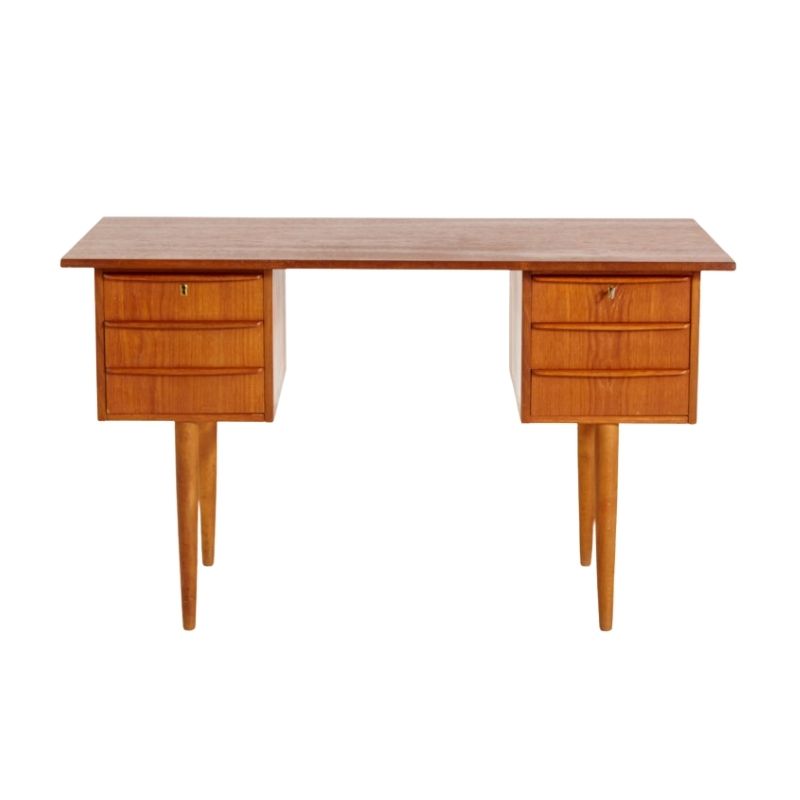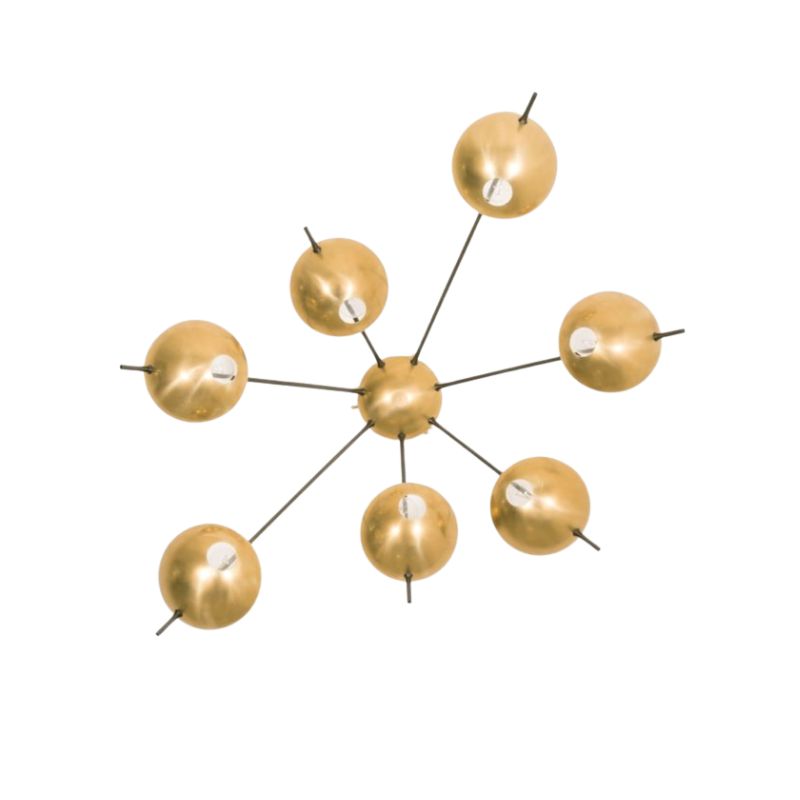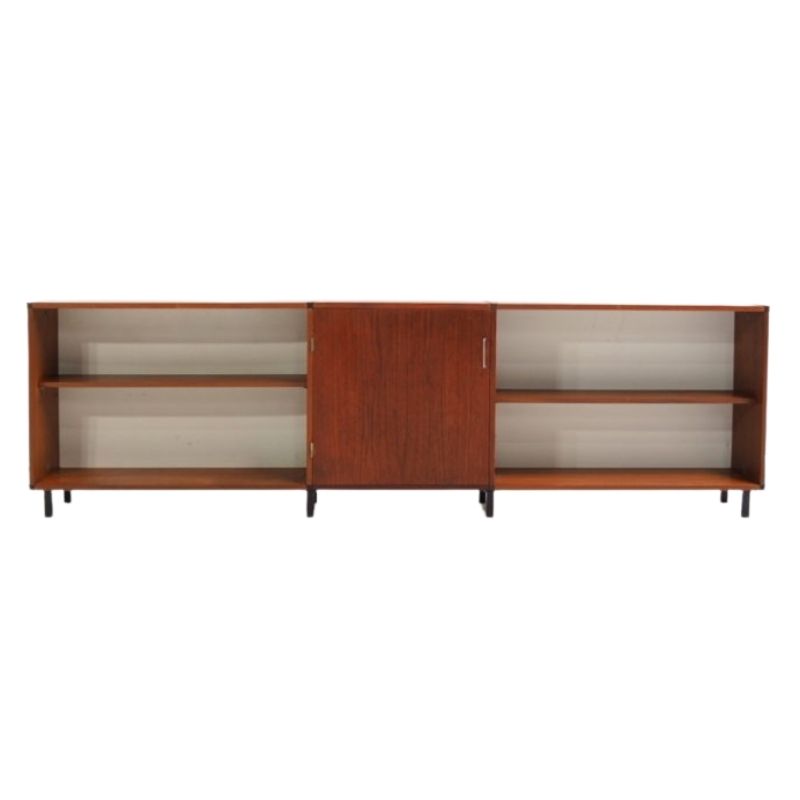I found a couple of Wegner's Wishbone chairs recently. They are Carl Hansen's early production. I have a couple of questions:Finish: they are fumed oak based on the color, but they don't appear to have any finish on the oak. The oak is quite dry. Would these have originally had a soap finish that hasn't been renewed in ages? a non-drying oil that has evaporated? (If they were ever finished with a drying oil, it was long, long ago, and very thinly applied).Brand and Age: One of the chairs has the "known" early Carl Hansen mark. The other is branded "MADE IN DENMARK." I don't have any reasonable doubts about the authenticity of the chair (I would be happy to enumerate evidence if someone is interested), but I am curious about the mark. Anyone seen it on Carl Hansen's production before?<img class="wpforo-default-image-attachment wpforoimg" src=" http://old.designaddict.com/sites/default/files/forum/P1020623.
I just found one of these too, with a paper label. I'm pleased that your chair appears to be the same color as mine (when mine is not directly under an incandescent light bulb in the closet, that is).
This DA link doesn't answer your questions, but has further discussion about the labels...
http://www.designaddict.com/forum/General-discussion/labels-Hans-Wegner-...
I sure wouldn't mind elaboration on the evidence of authenticity, as these things are knocked off like crazy... I know the one piece top rail is definitely something to pay attention to... What proves it to you?
Well it is absolutely identical in every way to the sibling chair with the common early brand that has lived with it for 60 odd years. Except for the different brand.
Near the brand on all the old specimens I can find there is a craftsman's or inspector's impressed number, in a specific font. The chair in question evidences this.
There is another early Carl Hansen mark that is branded on with wide letters similar to the brand on the chair in question. Which makes it plausible there are more marks not yet well known, and that they might be brands with wider letters.
I have yet to see a a Danish made period replica of a Danish piece of furniture. So I seems unlikely in the highest that I have found the first. (There are plenty of instances of similar designs, but not replicas) But if we hypothesize it did happen in general. then it is extraordinarily difficult to explain the craftsman's number on this chair. The replica maker would have had to have gone out if his way to purchase the same stamps. The only cogent hypothetical explanation would be that it was a period forgery. But then we can not explain why the hypothetical forger used used an uncommon brand. Finally, in this vein, it does not seem likely that a hypothetical forgery or replica would end up sibling to an authentic chair. Why pay full price for one, and get the replica/forgery discount in the other?
Finally returning to the first point this isn't an easy chair to make. Th economics of a replica don't make sense if the business plan is to make the chair just as perfectly as the original.
So adding it all together I simply can't see any reasonable theory by which the chair is not original.
I will try asking the Carl Hansen employee mentioned in that thread about it. I sent an email to a general box, but haven't heard back.
My curiosity with the brand is primarily related to dating the chairs. I suspect that they were on the cusp between these two marks, and so it may be possible to date them more precisely than is usual, if Carl Hansen has information on date ranges for the two marks.
One final piece of evidence: in addition to the impressed number there is nearly always a pencil mark set of initials. Again for a craftsman or inspector. Especially on the early marks. My chair in question, the Danish language marked chairs in my last post, and the mark in this post all show RM initials. (My chair shows them upside down, and the curve of the R is hard to see in the photo).
So, I believe all three chairs were touched by a Carl Hansen employee whose initials were RM.
edit: in fact they are all upside down. It appears to have been his preference to initial from that side of the chair.
Both of my wishbone chairs have pencil inscriptions. One is an "E", and the other is not really legible. The huge "Made In Denmark" stamp that your chair has seems to be done with a certain degree of intent... I have often wondered if some U.S. furniture dealers specified to Danish suppliers that they did not want furniture that was stamped with the manufacturer's name, so that clients would be less likely to inquire at other competing dealers if they too could order Carl Hansen, or France&Daverkosen, etc., etc.
I also would not be surprised if some dealers had bargained for an exclusive right to carry the branded furniture, while the Danish manufacturer would have other dealers carry the same furniture in an unbranded form.
I have the opportunity to purchase two of these chairs. I gave a refundable down payment and went home to research...
These two chairs had no sticker, stamp or embossment, only an eligible penciled initial.
I find (online) no evidence of the original NOT having any indicating marks.
I looked up original dimensions, wrote them down and took my German tape measure to their shop. The numbers were all wrong, only one (the front leg to floor height) matched.
the patina, the beautiful joinery, the wood- everything seemed so perfect and I'd have gotten them for a decent pre-restoration price.
I got my down payment back and went home to stare at my piles of unfinished furniture.
Something in me is doubting my course of action. Would the numbers really be that off it they are authentic?
I have the opportunity to purchase two of these chairs. I gave a refundable down payment and went home to research...
These two chairs had no sticker, stamp or embossment, only an eligible penciled initial.
I find (online) no evidence of the original NOT having any indicating marks.
I looked up original dimensions, wrote them down and took my German tape measure to their shop. The numbers were all wrong, only one (the front leg to floor height) matched.
the patina, the beautiful joinery, the wood- everything seemed so perfect and I'd have gotten them for a decent pre-restoration price.
I got my down payment back and went home to stare at my piles of unfinished furniture.
Something in me is doubting my course of action. Would the numbers really be that off it they are authentic?
I've seen Danish chairs of the same design but years apart in manufacture and the seat heights were significantly different. I think they might have been wishbones but it was awhile ago and it was just in passing so I don't really remember. But I would say yes, it happens.
That doesn't mean they were real, though. It's hard to say without photos.
Regarding the discussion about the penciled intitials---didn't that Danish guy who used to work as a seat weaver for Carl Hansen or PP Mobler say that the initials on a chair that someone had were of the old guy who wove the seat? I've always thought they were the weavers' initials but maybe I got that idea from misremembering what the Danish guy said (espen? something like that). It does make sense to me, though.
If you need any help, please contact us at – info@designaddict.com













